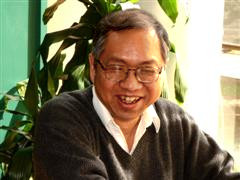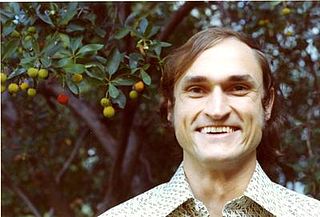Related Research Articles
The Nash embedding theorems, named after John Forbes Nash Jr., state that every Riemannian manifold can be isometrically embedded into some Euclidean space. Isometric means preserving the length of every path. For instance, bending but neither stretching nor tearing a page of paper gives an isometric embedding of the page into Euclidean space because curves drawn on the page retain the same arclength however the page is bent.

In mathematics, complex geometry is the study of geometric structures and constructions arising out of, or described by, the complex numbers. In particular, complex geometry is concerned with the study of spaces such as complex manifolds and complex algebraic varieties, functions of several complex variables, and holomorphic constructions such as holomorphic vector bundles and coherent sheaves. Application of transcendental methods to algebraic geometry falls in this category, together with more geometric aspects of complex analysis.

In Riemannian geometry, an exponential map is a map from a subset of a tangent space TpM of a Riemannian manifold M to M itself. The (pseudo) Riemannian metric determines a canonical affine connection, and the exponential map of the (pseudo) Riemannian manifold is given by the exponential map of this connection.

In geometry, parallel transport is a way of transporting geometrical data along smooth curves in a manifold. If the manifold is equipped with an affine connection, then this connection allows one to transport vectors of the manifold along curves so that they stay parallel with respect to the connection.

Shing-Tung Yau is a Chinese-American mathematician and the William Caspar Graustein Professor of Mathematics at Harvard University.
In mathematics and especially differential geometry, a Kähler manifold is a manifold with three mutually compatible structures: a complex structure, a Riemannian structure, and a symplectic structure. The concept was first studied by Jan Arnoldus Schouten and David van Dantzig in 1930, and then introduced by Erich Kähler in 1933. The terminology has been fixed by André Weil. Kähler geometry refers to the study of Kähler manifolds, their geometry and topology, as well as the study of structures and constructions that can be performed on Kähler manifolds, such as the existence of special connections like Hermitian Yang–Mills connections, or special metrics such as Kähler–Einstein metrics.
In mathematics, the Chern theorem states that the Euler-Poincaré characteristic of a closed even-dimensional Riemannian manifold is equal to the integral of a certain polynomial of its curvature form.

Georges de Rham was a Swiss mathematician, known for his contributions to differential topology.
In differential geometry, the curvature form describes curvature of a connection on a principal bundle. The Riemann curvature tensor in Riemannian geometry can be considered as a special case.
In the mathematical field of differential geometry, Ricci-flatness is a condition on the curvature of a (pseudo-)Riemannian manifold. Ricci-flat manifolds are a special kind of Einstein manifold. In theoretical physics, Ricci-flat Lorentzian manifolds are of fundamental interest, as they are the solutions of Einstein's field equations in vacuum with vanishing cosmological constant.
In the mathematical field of Riemannian geometry, the fundamental theorem of Riemannian geometry states that on any Riemannian manifold there is a unique affine connection which is torsion-free and metric-compatible, called the Levi-Civita connection or (pseudo-)Riemannian connection of the given metric. Because it is canonically defined by such properties, often this connection is automatically used when given a metric.

Richard Melvin Schoen is an American mathematician known for his work in differential geometry and geometric analysis. He is best known for the resolution of the Yamabe problem in 1984.
In mathematics, and more specifically in differential geometry, a Hermitian manifold is the complex analogue of a Riemannian manifold. More precisely, a Hermitian manifold is a complex manifold with a smoothly varying Hermitian inner product on each (holomorphic) tangent space. One can also define a Hermitian manifold as a real manifold with a Riemannian metric that preserves a complex structure.
In the mathematical field of differential geometry, a smooth map between Riemannian manifolds is called harmonic if its coordinate representatives satisfy a certain nonlinear partial differential equation. This partial differential equation for a mapping also arises as the Euler-Lagrange equation of a functional called the Dirichlet energy. As such, the theory of harmonic maps contains both the theory of unit-speed geodesics in Riemannian geometry and the theory of harmonic functions.

In mathematics, an immersion is a differentiable function between differentiable manifolds whose differential is everywhere injective. Explicitly, f : M → N is an immersion if
In mathematics, the Cartan–Hadamard theorem is a statement in Riemannian geometry concerning the structure of complete Riemannian manifolds of non-positive sectional curvature. The theorem states that the universal cover of such a manifold is diffeomorphic to a Euclidean space via the exponential map at any point. It was first proved by Hans Carl Friedrich von Mangoldt for surfaces in 1881, and independently by Jacques Hadamard in 1898. Élie Cartan generalized the theorem to Riemannian manifolds in 1928. The theorem was further generalized to a wide class of metric spaces by Mikhail Gromov in 1987; detailed proofs were published by Ballmann (1990) for metric spaces of non-positive curvature and by Alexander & Bishop (1990) for general locally convex metric spaces.
In mathematics, the Riemannian connection on a surface or Riemannian 2-manifold refers to several intrinsic geometric structures discovered by Tullio Levi-Civita, Élie Cartan and Hermann Weyl in the early part of the twentieth century: parallel transport, covariant derivative and connection form. These concepts were put in their current form with principal bundles only in the 1950s. The classical nineteenth century approach to the differential geometry of surfaces, due in large part to Carl Friedrich Gauss, has been reworked in this modern framework, which provides the natural setting for the classical theory of the moving frame as well as the Riemannian geometry of higher-dimensional Riemannian manifolds. This account is intended as an introduction to the theory of connections.

Shoshichi Kobayashi was a Japanese mathematician. He was the eldest brother of electrical engineer and computer scientist Hisashi Kobayashi. His research interests were in Riemannian and complex manifolds, transformation groups of geometric structures, and Lie algebras.
In mathematics, Salomon Bochner proved in 1946 that any Killing vector field of a compact Riemannian manifold with negative Ricci curvature must be zero. Consequently the isometry group of the manifold must be finite.
References
- Kobayashi, S.; Nomizu, K. (2009) [1963]. Foundations of Differential Geometry. Wiley Classics Library. Vol. 1. Wiley. ISBN 978-0-471-15733-5. Zbl 0119.37502.
- Kobayashi, S.; Nomizu, K. (2009) [1969]. Foundations of Differential Geometry. Wiley Classics Library. Vol. 2. Wiley. ISBN 978-0-471-15732-8. Zbl 0175.48504.
- Eells, J. (1963). "Review of Volume 1" (PDF). Mathematical Reviews .
- Hermann, Robert (1964). "Review: Foundations of differential geometry, Volume 1". Bulletin of the American Mathematical Society . 70 (2): 232–235. doi: 10.1090/s0002-9904-1964-11094-6 .
- Eells, J. (1969). "Review of Volume 2" (PDF). Mathematical Reviews.